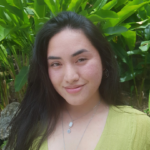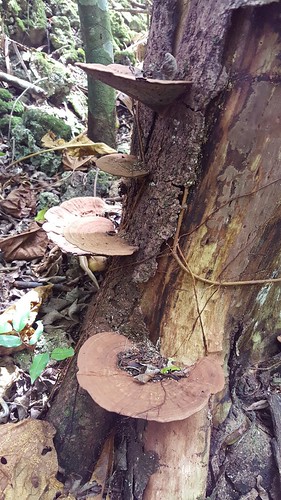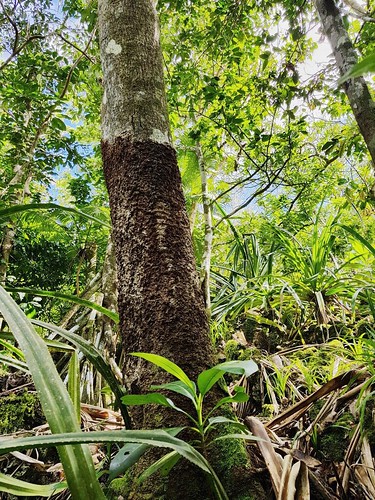Fungus in Guam’s Forests
Fungi help make the jungle work
Fungi are some of the most important organisms in an ecosystem. A variety of fungi are used as food sources and antibiotics, and some break down decaying matter into useful, organic material. There are three main categories of fungi:
- Mycorrhizal fungi form healthy symbiotic relationships with many living tree species. These “mycorrhizae” help a plant’s root better supply the plant with minerals and nutrients.
- Saprophytic fungi, on the other hand, prefer to feed on dead and decaying organisms. These “saprophytes” may be seen on dead animals and insects, dead leaves, and fallen trees, as well as dead standing trees.
- Pathogenic fungi, sometimes known to cause a number of diseases in animals and plants.
Of the three fungus categories, pathogenic fungi have the second-highest number of recorded or described species after saprophytic fungi. Pathogenic fungi can cause serious damage to croplands and, especially, to forest ecosystems. After a heavy storm, such as a typhoon, fungal spores may infect damaged trees, causing wood rot.
The effect of pathogenic fungi
Just as different plants and animals have certain habitat preferences, fungi, too, prefer some environments over others.
Some common pathogenic fungi, such as Ganoderma sp. and Phellinus noxius thrive at the butt (base of trunk) of trees, directly above the roots. Here, there is a lot of moisture and the tree is relatively unprotected, as opposed to the top of the tree where it is protected by plentiful leaves.
Ganoderma sp. are bracket fungi. They form hard, woody, shelf-like growths on the trunk of a tree. These growths (see Figure 1) are called conks.
Phellinus noxius is most known for causing brown root rot on trees (see Figure 2). It has been found in many parts of the Asian-Pacific region, from Malaysia to as far as American Samoa. The disease has killed many breadfruit (“lemai”; Articarpus altilis) trees, which provide an important food crop throughout Micronesia; as well as ornamental trees, such as the flame tree (Delonix regia) in Saipan.
In other islands of Micronesia, such as Kosrae and Palau, conks produced by Ganoderma sp. can be seen on indigenous trees such as the “ka” tree (Terminalia carolinensis) and mangrove trees (Rhizophora spp.) Many urban and forest trees throughout Guam and other islands of Micronesia are susceptible to these pathogens.
The fungal pathogens P. noxius and Ganoderma sp. appear to show no preference for either native or non-native species of trees (see Tables 1 & 2).
Table 1. Trees found on Guam known to be susceptible to brown root rot.
| Species name | Common name | CHamoru term | Nativity |
|---|---|---|---|
| Guamia mariannae | fingersop | paipai | endemic |
| Macaranga thompsonii | N/A | pengua | endemic |
| Articarpus altilis | breadfruit | lemai | indigenous |
| Ochrosia oppositifolia | lipstick tree | langiti | endemic |
| Persea americana | avocado | alageta | non-native |
Table 2. Trees found on Guam known to be susceptible to Ganoderma sp.
| Species name | Common name | CHamoru term | Nativity |
|---|---|---|---|
| Casuarina equisetifolia | ironwood | gågu | indigenous |
| Serianthes nelsonii | håyun lågu | endemic |
Attacking useful and endangered trees
Guam’s forest ecosystems are home to a mixture of native, naturalized, and non-native plant species. In the northern limestone forests, brown root rot can create large spaces of fallen trees (see Figure 3). And the conks produced by the fungus Ganoderma sp. can be seen on gågu (Casuarina equisetifolia) and håyun lågu (Serianthes nelsonii).

The gågu is used as windbreaks for protection from heavy winds and can be seen along the perimeter of farmlands as well as coastlines. The håyun lågu is on the endangered species list. There is only one mature tree of its kind left in the wild on Guam. Overall, Phellinus noxius and Ganoderma sp. are important for local foresters and researchers to manage as they work to protect and conserve native trees.
About the author

Meghan Borja was a graduate student at the University of Guam currently working toward a master of science degree in environmental science. She was an Extension Associate I at the UOG College of Natural & Applied Sciences (CNAS), working with extension plant pathologist Dr. Robert Schlub. She was also a biology teacher at Southern High School. Her interests include sharing eco-friendly lifestyle hacks and island sustainability tips on Instagram.
Editor’s note: This author was a beginning graduate student in 2019 taking a course in scientific writing at the University of Guam. This article was assigned to provide the student with practice in communicating science to non-scientists. The student chose the topic which is related either to her thesis project or work experience. The instructor in the course is Dr. Laurie Raymundo, a UOG Marine Laboratory faculty member.
For further reading
Marler, Thomas, and Cameron Musser. “Potential Stressors Leading to Seedling Mortality in the Endemic Håyun Lågu Tree (Serianthes nelsonii Merr.) in the Island of Guam.” Tropical Conservation Science 8, no. 83 (2015): 738-744.
Raulerson, Lynn, and Agnes F. Rinehart. Trees and Shrubs of the Mariana Islands. 2nd ed. Mangilao: University of Guam Press, 2018.
Taborosi, Danko, David R. Burdick, and Frank Camacho. Environments of Guam. Honolulu: Bess Press, 2013.
University of Guam Cooperative Extension Service. Gago, Guam Ironwood Tree, Casuarina equisetifolia: Past, Present, Future. Edited by Robert Schlub. Technical Report. Mangilao: CES, 2013.
US Department of Agriculture Forest Service. Forest Pathology in Yap, Palau, Pohnpei, Kosrae, Guam and Saipan. By Phil Cannon. Trip Report. Vallejo: FHP, 2014.

